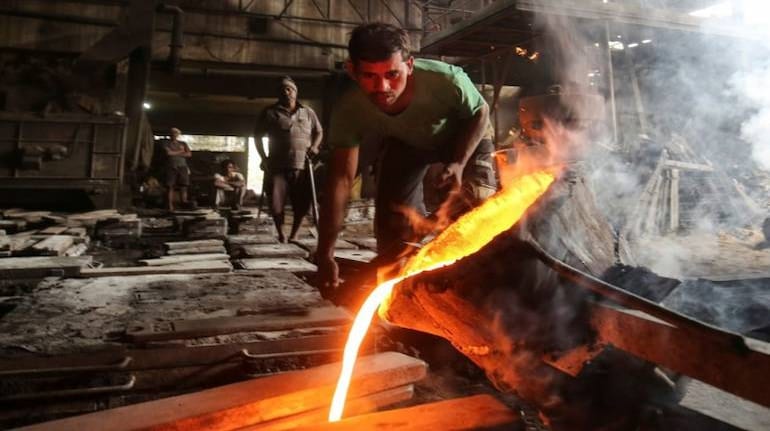



Tata Steel’s digital platform, Connected Workforce, is like a Google Map, and every worker carries a Suraksha card while in the workplace. As soon as any worker among Tata Steel’s 75,000-strong contract labour force enters a high-hazard area or a place where he is not supposed to be, an alert goes to a Quick Response Team (QRT) to defuse the situation.
Atrayee Sanyal, Vice President of Human Resource Management at Tata Steel, told Moneycontrol that the Tata company was also reducing safety risks, including by standardising technological interventions for critical equipment such as Electric Overhead Travelling Cranes, Conveyor Belts, and Wagon Tipplers in India, using of robots for dross removal at zinc baths in the Netherlands and access control at hazardous locations while also improving the maturity of digital and technological projects.
Across sector, companies are looking at tech intervention to protect employees from workplace hazards as the digital revolution disrupts shop floor practices. According to media reports, registered factories in India reported over 1,100 deaths and more than 4,000 injuries each year during 2016-20 caused by workplace hazards.
Optical sensors for moving objects, automating tasks involving heavy machinery and use of wearables to detect harm in the workers’ way early, among others, are a few measures being taken to preempt injuries to workers.
At Godrej & Boyce, the key focus is to minimise the interaction between man and machine using appropriate automation. The next circle of security is the installation of physical barriers with sensors such as laser curtains and interlocks, said Zurvan Marolia, Senior Vice President and Head of Manufacturing the Council at Godrej & Boyce.
Reducing lost-time casesHarman International, a wholly owned subsidiary of Korean electronics giant Samsung, has deployed optical sensors for moving objects. Moving machines and objects are prone to causing injury and are protected by optical sensors and curtains that restrict human access to such objects when they are in movement.
Harman claims to have achieved a milestone by surpassing a period of 8 years and over 3,000 days without a Lost Time Case (LTC) by March 31, 2023. LTCs are occupational injuries or illness that result in an employee being unable to work an assigned shift.
“These technologies have effectively mitigated risks associated with various hazards such as moving machinery, hazardous gases, high noise levels, electric shocks, and short circuits,” said Sanjeev Kulkarni, Vice President of Automotive at Harman India.
Engineering services company Schneider Electric has deployed an LDS (Lean Digitization system) for operators to report safety opportunities in the shop floors and DISS (Digitized Idea & SIM System) which enables operators to give safety suggestions on that can also be tracked for closure.
“We have a GlobES Tool where all types of incidents are reported through Safety Enablon (a mobile app), this is mostly for supervisors and managers,” said Nitin Bakshi, Vice President Global Supply Chain- India, MEA, SAM & Pacific at Schneider Electric.
For the current year, Schneider said it has reported zero lost time and medical accidents in its facilities.
Turning preemptiveAt energy storage firm Cygni Energy, sensors and wearables are used to monitor the workplace environment and the health of employees. For example, sensors can be used to detect dangerous levels of chemicals or gases in the air. Wearables can be used to monitor the physical well-being of employees.
They can track vital signs such as heart rate and blood pressure, and alert employees and management if there is a potential problem. “With the continued development of technology, we can expect to see further improvements in workplace safety in the manufacturing industry,” said Venkat Rajaraman, Chief Executive Officer and founder of Cygni Energy.
ALSO READ | EV companies focus on lateral hiring, upskilling employees amid fresh talent crunchTo mitigate this risk of burns, cuts and other injuries, commercial oven manufacturer UNOX India is automating certain tasks in the manufacturing process that are typically manual such as handling hot ovens or cutting metal.
Robotics, too, have been incorporated to handle heavy lifting tasks and other strenuous work that might pose a risk to human workers, plus streamlining the production line to meet demand, said Vikram Goel, Managing Director of UNOX India.
Experts say much more needs to be done.
“Apart from present tech intervention, we would be happy to see increased use of simple low-cost safeguarding on power presses in the auto sector supply chain in India,” said Sandeep Sachdeva, co-founder and CEO of Safe In India Foundation (SII).
SII, a civil society organisation started by three alumni of Indian Institute of Management-Ahmedabad, assists workers in accessing Employees State Insurance Corp healthcare, compensations and facilitating their ESIC claims. It also strives to prevent accidents in the auto sector.
More than 585 workers in the Indian auto sector supply chain lost their hands or fingers in the auto industry hubs of Gurugram, Faridabad and Pune in the period from April 2021 to August 2022, according to an SII report that illustrates the dangerous working conditions in factories that employees are often exposed to.
ALSO READ | Crush injuries and insurance woes: Life of workers at Indian auto sector supply chain“Improving worker safety needs a comprehensive response that apart from technology, addresses strengthening safety regulations, improving enforcement, promoting safety culture and investing in safety training and equipment,” Sachdeva added.
Discover the latest Business News, Sensex, and Nifty updates. Obtain Personal Finance insights, tax queries, and expert opinions on Moneycontrol or download the Moneycontrol App to stay updated!
Find the best of Al News in one place, specially curated for you every weekend.
Stay on top of the latest tech trends and biggest startup news.